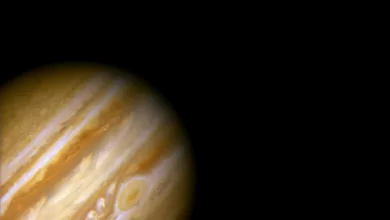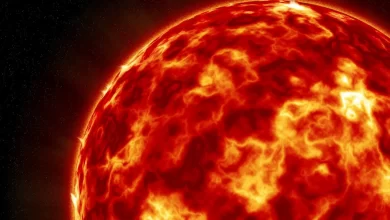A black hole is a dying star that has depleted all its fuel. The star is kept from collapsing in on itself by the pressure created by its fuel, but when it runs out of hydrogen, it collapses on itself and becomes so small that it literally vanishes from the universe.
- A black hole is an astronomical object that has a gravitational pull enormously strong that nothing, not even light, can escape out of it. The surface of the black hole is called its event horizon; it is defined as the boundary where the velocity needed to escape exceeds the speed of light, which is the speed limit of the cosmos.
- Stars with really strong gravity cause themselves to become smaller and smaller and eventually turn into black holes.
- Information about what has fallen into a black hole is stored on the black hole’s event horizon.
- Black holes are of four main sizes: (i)Micro black hole which has approx. mass of up to MMoon and radius of up to 0.1 mm,
(II) stellar-mass black hole, which has a mass of approximately 10 MSun and has a radius of 30 km.
(iii) intermediate-mass black hole has a mass of approx 103 MSun and has a radius of 103 km ≈REarth.
(iv) supermassive is the biggest kind of black hole with an approx mass of 105–1010 MSun and Approx radius of 0.001–400 AU (astronomical unit)(*1 AU= average, or mean, the distance between Earth and the Sun, defined as 149,597,870.7 km). - The more massive the black hole, the bigger the galaxy. Some supermassive black holes are billions of times the mass of the sun, with events horizons larger than the solar system.
- The more massive the black hole, the bigger the galaxy. Some supermassive black holes are billions of times the mass of the sun, with events horizons larger than the solar system.
- Normal-sized black holes vanish after a long time. The black hole would disappear in an explosion of particles and energy.
- The swirling gases around a black hole turn it into an electrical generator, making it spout jets of electricity billions of kilometers out into space.
- A black hole in the Perseus galaxy, which is 300 million light-years away, has been emitting an extremely low musical sound note for more than two billion years. According to scientists of NASA’s Chandra X-ray Center, the tone registers 57 octaves below middle C, which is a resounding B-flat.
- The Milky Way’s supermassive black hole, Sagittarius A, is around 4 million times the mass of the sun and is 25,640 light-years away.
- Our sun cannot become a black hole. However, if it is somehow compressed enough to become a black hole, it would be less than 4 miles (6 km) across. If this happens, the sun will exert no more gravitational force on Earth or Other planets in our solar system than it does now.
- The gravitational field inside a black hole is so strong that it can gulp everything in the universe, including a passing star and its light. If an object weighing 1 kg is brought to within 6m of a black hole, it will weigh a million million tonnes.
- If you fell into a black hole by the feet first, the gravitational pull will be much more intense than on your head. Each bit of your body would also be elongated in slightly different directions, just like spaghetti.
- To a distant observer, a clock near a black hole would appear to tick more slowly, and this is gravitational time dilation. To the same observer, an object falling into a black hole would appear to slow down as it approached the event horizon, taking an infinite amount of time to reach it.
- The opposite of black holes is estimated to be white holes that spray out matter and light like fountains.
- Cosmologists believe that most of the galaxies have a supermassive black hole at their center, with a mass of between 1 million or billions of times than that of the sun. All of a black hole’s matter is crushed into a tiny point of infinite gravity called a singularity.
- The singularity in a black hole has no volume; hence it has infinite density.
- The nearest known black hole is 1,600 light-years (10 quadrillion miles/16 quadrillion kilometers) away.
- The concept of black holes goes back to the 1780s when “dark stars” were envisioned.
- The diameter of a black hole is the diameter of the event horizon.
- In 1967 American physicist, John Wheeler dubbed the term “black hole.”
- Bigger black holes are created when black holes and galaxies collide.
- A supermassive black hole is believed to be present in the center of nearly every galaxy, including our own Milky Way.
- A binary black hole (BBH) is a system consisting of two black holes in close orbit around each other.
- Binary black holes have been found sitting in the center of quasar SDSS 153636.22+044127.0 at a distance of about 4 billion light-years from Earth.
- If the earth were to become a black hole, it would create an event horizon of just 1.7 centimeters.
- In late March of 2011, astronomers observed for the first time an extraordinary event: a black hole in a distant galaxy tore apart and ate a whole star!
- A black hole is formed when the matter is crushed to infinite density. To make a black hole from the earth, you would have to crush the entire planet, including everything on it, down to the size of a pea.
- At the core of the radio galaxy, Centaurus A is a supermassive black hole, hundreds of millions of times the mass of the sun. From above and below this violent gravity well, jets of matter shoot out at near light speed in two huge plumes. Each plume is over a million light-years long; 10 Milky Way galaxies would fit along each plume’s length.
- Black holes are extremely efficient; if a car was as efficient as a black hole, it could travel 1 billion miles on one gallon of petrol.
- In the year 2020, scientists reported that a black hole spewed out material equivalent to 500 Empire State Buildings at nearly 60 percent of the speed of light.
- Cosmic rays are particles traveling at near light speed that are thought to come from black holes or supernovas. When these cosmic rays hit our atmosphere, they produce a shower of slower-moving particles that can hit the surface. These can cause faults in electronic devices like computers and other devices.
- A star orbiting a black hole can travel at over 200,000 kilometers an hour.
- The NASA scientists believe that a giant black hole at the center of the Milky Way may be vaporizing and devouring asteroids.
- Black holes absorb dark matter, and over the billions of years since galaxies were first formed, this absorption of dark matter in black holes has very likely made an impact on the population of galaxies from what we can observe today.
- The tightly coiled and powerful magnetic fields that corkscrew into the spinning accretion disks of black holes can whip up winds blowing at 300 (482 km) miles per second.
- In theory, there is no minimum size for a black hole.
- The defining feature of every black hole is the so-called “event horizon.” The event horizon is a surface in space-time that marks a point of no return, and once an object crosses this surface, it cannot return to the other side.
- The black hole at the center of the Sombrero Galaxy weighs in at 1 billion times that of the sun, one of the most massive black holes ever measured.
- A feeding black hole has an accretion disk surrounding it. This is a very extreme environment, which has intense magnetic fields. These magnetic fields funnel high-energy particles into a narrow jet traveling at close to the speed of light, erupting from above and below the black hole. These jets can be so long that their length can exceed the host galaxy’s diameter.
- In 1972 Tom Bolton discovered the first black hole in Cygnus X-1.
- Quasars are so bright they can vastly outshine our entire Milky Way Galaxy and are among the brightest objects. They’re produced by matter falling towards a violent and feeding supermassive black hole at the center of a galaxy, usually hundreds of millions of times the mass of the sun. The matter circles the black hole in the accretion disk at tremendous speeds, emitting large amounts of light as it gets destroyed by colossal gravity.
- Gamma rays are produced in the hottest and most violent events in the universe, such as the birth of a black hole. Gamma rays have the most energy of any other part of the electromagnetic spectrum and have a wavelength shorter than the width of an atom. Gamma-ray light is lethal and can easily damaging human DNA. Gamma-ray light cannot be reflected with mirrors as the waves will pass right between the atoms of the mirror.
- The black hole at the heart of the elliptical galaxy M87 weighs in with a mass of at least 2 billion times that of our sun. Traveling at near light speed from the disk of gas and dust orbiting the black hole is a 5,000 light-year-long jet of matter ejected from the galaxy.
References
- Wikipedia-Black Hole
- Britannica-Black Hole
- Scientificamerican.com(black hole that sings)
- Forbes.com(closest black hole)
- Spaceplace.nasa.gov(What if sun becomes an blackhole )
- Astronomy.com(what would happen if you will fall into a black hole )
- Forbes.com






